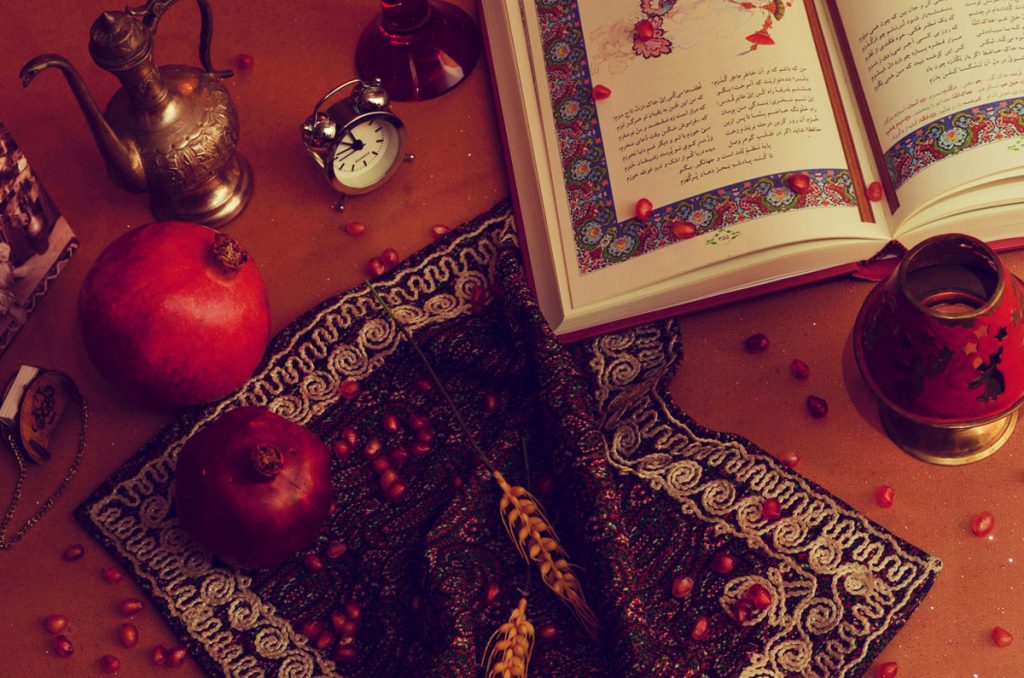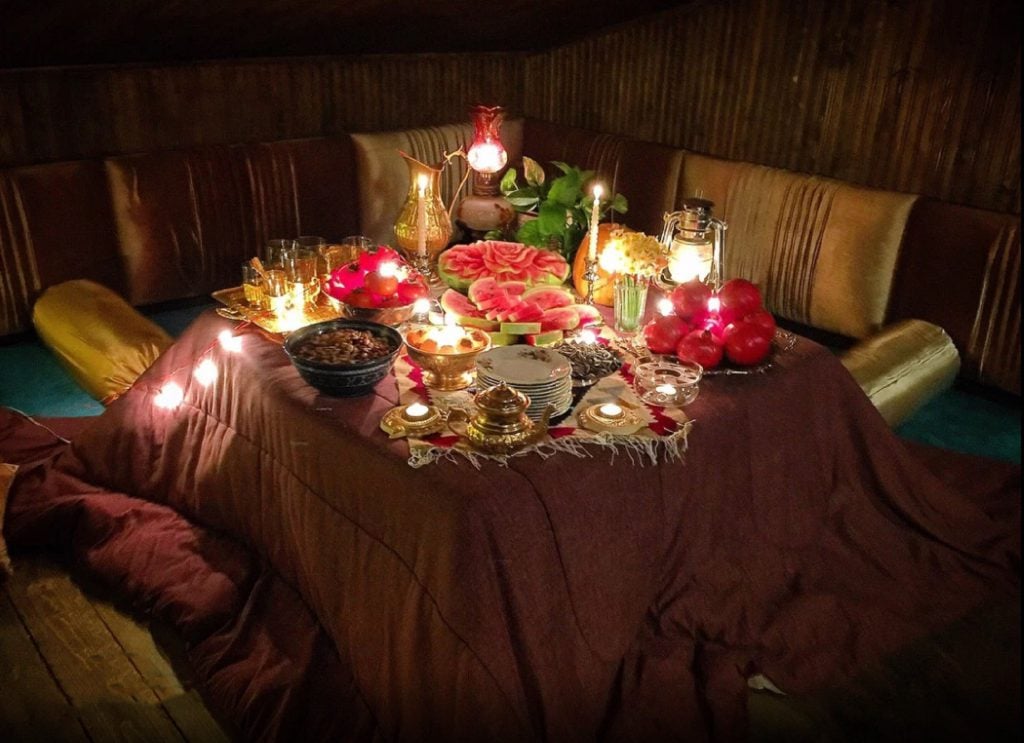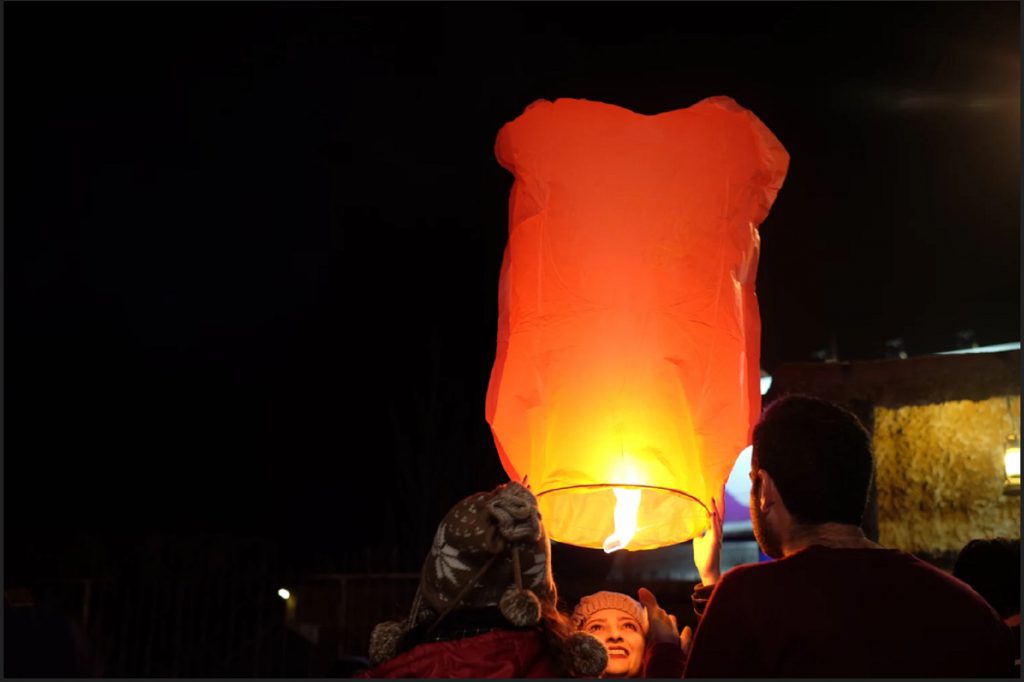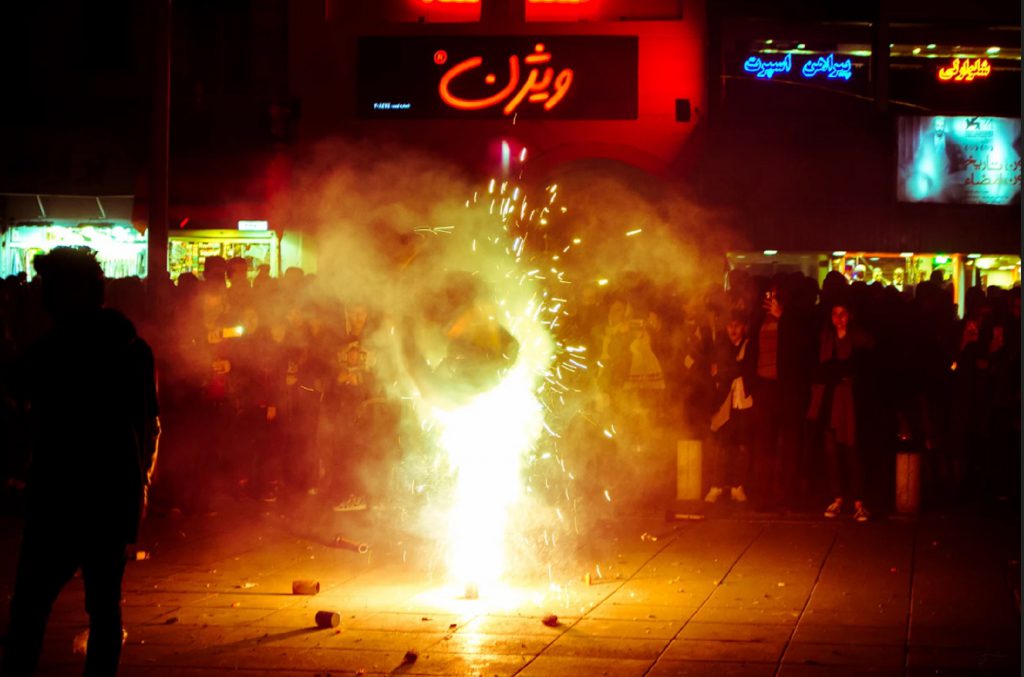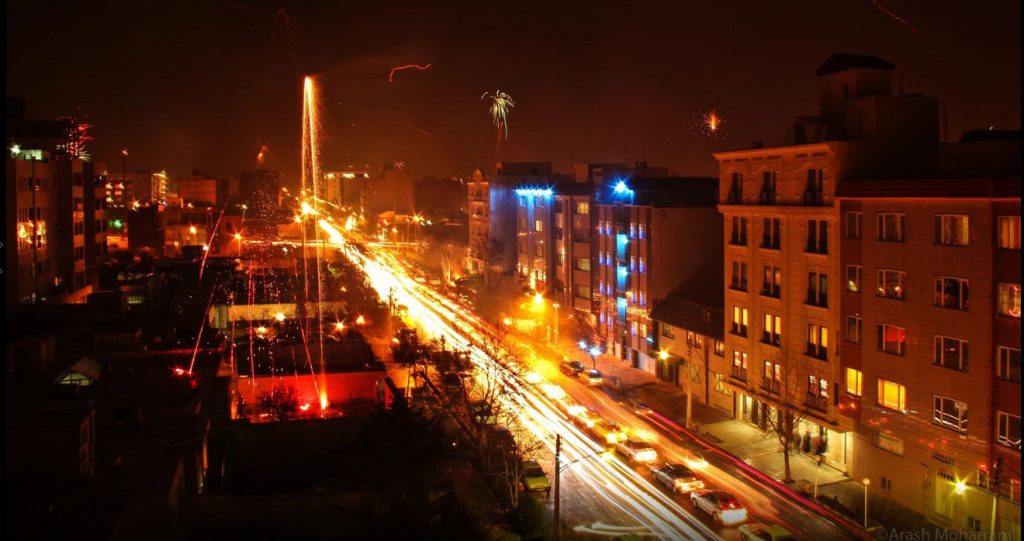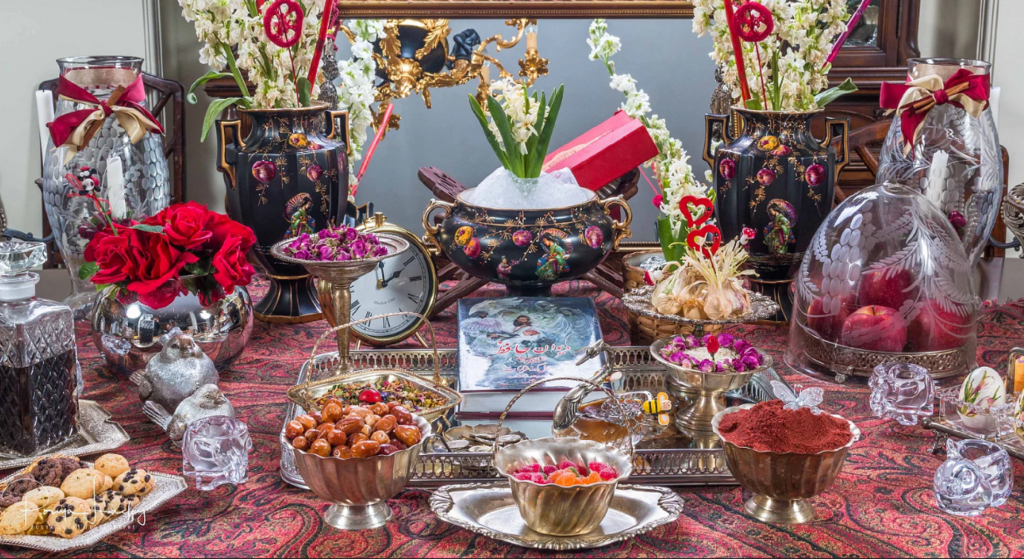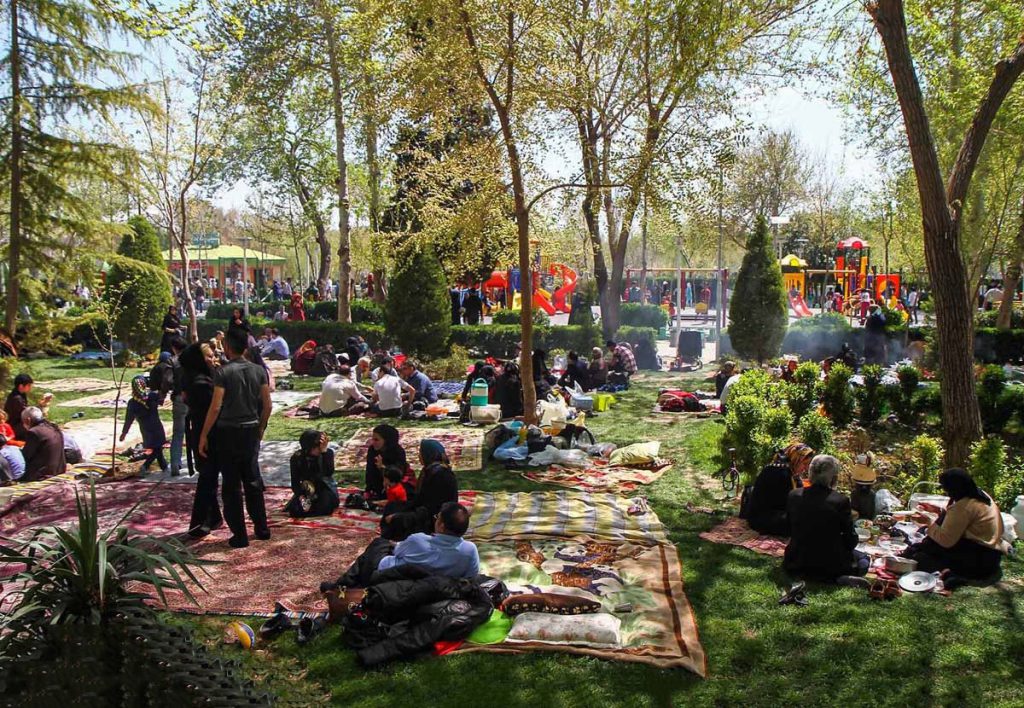Iran holidays tend to center around the Muslim religion, with most celebrating a holiday or event. Festivals vary greatly by region due to Iran’s multi-ethnic make-up. Visitors should note that when watching or participating in any religious event, conservative dress is a must and women may want to cover their heads. Ask your tour guide or hotel what customs need to be followed so as not to offend anyone.
this part continues Carnivals and holidays part1
Yalda Festival (Shab e Cheleh)
Yalda, a Syrian word imported into the Persian language by the Syrian Christians means birth (tavalud and melaad are from the same origin). It is a relatively recent arrival and it is referred to the “Shab e Cheleh Festival” a celebration of Winter Solstice on December 21st. Forty days before the next major Persian festival “Jashn e Sadeh” this night has been celebrated in countless cultures for thousands of years. The ancient Roman festivals of Saturnalia (God of Agriculture, Saturn) and Sol Invicta (Sun God) are amongst the best known in the Western world.
In most ancient cultures, including Persia, the start of the solar year has been marked to celebrate the victory of light over darkness and the renewal of the Sun. For instance, Egyptians, four thousand years ago celebrated the rebirth of the sun at this time of the year. They set the length of the festival at 12 days, to reflect the 12 divisions in their solar calendar. They decorated with greenery, using palms with 12 shots as a symbol of the completed year since a palm was thought to put forth a shoot each month.
The Persians adopted their annual renewal festival from the Babylonians and incorporated it into the rituals of their own Zoroastrian religion. The last day of the Persian month Azar is the longest night of the year when the forces of Ahriman are assumed to be at the peak of their strength. While the next day, the first day of the month “Day” known as “khoram Rooz” or “khore Rooz” (the day of sun) belongs to Ahura Mazda, the Lord of Wisdom. Since the days are getting longer and the nights shorter, this day marks the victory of Sun over the darkness. The occasion was celebrated in the festival of “Daygan” dedicated to Ahura Mazda, on the first day of the month “Day”
Fires would be burnt all night to ensure the defeat of the forces of Ahriman. There would be feasts, acts of charity and a number of deities were honored and prayers performed to ensure the total victory of the sun that was essential for the protection of winter crops. There would be prayers to Mithra (Mehr) and feasts in his honor, since Mithra is the Eyzad responsible for protecting “the light of the early morning” known as “Havangah” It was also assumed that Ahura Mazda would grant people’s wishes, especially those with no offspring had the hope to be blessed with children if performed all rites on this occasion.
One of the themes of the festival was the temporary subversion of order. Masters and servants reversed roles. The king dressed in white would change place with ordinary people. A mock king was crowned and masquerades spilled into the streets. As the old year died, rules of ordinary living were relaxed. This tradition persisted till the Sassanian period and is mentioned by Biruni and others in their recordings of pre-Islamic rituals and festivals. Its’ origin goes back to the Babylonian New Year celebration. These people believed the first creation was an order that came out of chaos. To appreciate and celebrate the first creation they had a festival and all roles were reversed. Disorder and chaos ruled for a day and eventually, an order was restored and succeeded at the end of the festival.
The Egyptian and Persian traditions merged in ancient Rome, in a festival to the ancient god of seedtime, Saturn. The Romans exchanged gifts, partied and decorated their homes with greenery. Following the Persian tradition, the usual order of the year was suspended. Grudges and quarrels were forgotten, wars would be interrupted or postponed. Businesses, courts, and schools were closed. Rich and poor became equal, masters served slaves, and children headed the family. Cross-dressing and masquerades, the merriment of all kinds prevailed. A mock king, the Lord of Misrule, was crowned. Candles and lamps chased away the spirits of darkness.
Another related Roman festival celebrated at the same time was dedicated to Sol Invictus (“the invincible sun” Originally a Syrian deity, this cult was imported by Emperor Heliogabalus into Rome and Sol was made the God of the state. With the spread of Christianity, Christmas celebration became the most important Christian festival. In the third century various dates, from December to April, were celebrated by Christians as Christmas. January 6 was the most favored day because it was thought to be Jesus’ Baptismal day (in the Greek Orthodox Church this continues to be the day to celebrate Christmas). In year 350, December 25 was adopted in Rome and gradually almost the entire Christian Church agreed to that date, which coincided, with Winter Solstice and the festivals, Sol Invicta and Saturnalia. Many of the rituals and traditions of the pagan festivals were incorporated into the Christmas celebration and are still observed today.
It is not clear when and how the world “Yalda” entered the Persian language. The massive persecution of the early Christians in Rome brought many Christian refugees into the Sasanian Empire and it is very likely that these Christians introduced and popularized “Yalda” in Iran. Gradually “Shab e Yalda” and “Shab e Cheleh” became synonymous and the two are used interchangeably.
With the conquest of Islam, the religious significance of the ancient Persian festivals was lost. Today “Shab e Cheleh” is merely a social occasion when family and friends get together for fun and merriment. Different kinds of dried fruits, nuts, seeds, and fresh winter fruits are consumed. The presence of dried and fresh fruits is a reminiscence of the ancient feasts to celebrate and pray to the deities to ensure the protection of the winter crops.
The Iranian Jews, who are amongst the oldest inhabitants of the country, in addition to “Shab e Cheleh” also celebrate the festival of “Illanout” (tree festival) at around the same time. Their celebration of Illanout is very similar to Shab e Cheleh celebration. Candles are lit; all varieties of dried and fresh winter fruits will have to be present. Special meals are prepared and prayers are performed. There are also very similar festivals in many parts of Southern Russia that are identical to “Shab e Cheleh” festival with local variations. Sweetbreads are baked in the shape of humans and animals. Bonfires are made; dances are performed that resemble crop harvesting. Comparison and detailed studies of all these celebrations no doubt will shed more light on the forgotten aspects of this wonderful and ancient festival, where merriment was the main theme of the festival. Happy Shab e Cheleh.
Festival of Fire (Chahar Shanbeh Soori)
Last Wednesday of the Iranian year known as Chahar Shanbeh Soori (Čahār Šanbé Sūrī – usually pronounced Čāršambé-sūrī), the eve of which is marked by special customs and rituals, most notably jumping over fire.
On the eve of last Wednesday of the year, literally the eve of ‘Red Wednesday’ or the eve of celebration, bonfires are lit in public places with the help of fire and light, it is hoped for enlightenment and happiness throughout the coming year. People leap over the flames, shouting:
Sorkhi-ye to az man; Zardi-ye man az to
Give me your beautiful red color; And take back my sickly pallor
With the help of fire and light symbols of good, Iranians wish to see their way through this last Wednesday of the year – the end of the year and to the arrival of springs longer days.
Traditionally, it is believed that the living was visited by the spirits of their ancestors on the last day of the year. Many people especially children, wrap themselves in shrouds symbolically re-enacting the visits. By the light of the bonfire, they run through the streets banging on pots and pans with spoons called Qashog-Zani to beat out the last unlucky Wednesday of the year, while they knock on doors to ask for treats. Indeed, Halloween is a Celtic variation of this night.
In order to make wishes come true, it is customary to prepare special foods and distribute them on this night. Persian Noodle Soup is known as Âsh, a filled Persian delight, and a mixture of seven dried nuts and fruits, pistachios, roasted chickpeas, almond, hazelnuts, figs, apricots, and raisins.
The ancient Iranians celebrated the last six days of the year in their annual obligation feast of all souls, Hamaspathmaedaya (Farvardigan or popularly Forodigan) which after the calendar reform under Ardašīr I, the founder of the fourth Iranian dynasty, the Sasanians (224-651 CE). They believed Foruhars (faravahar), the guardian-angles for humans and also the spirits of the dead would come back for a reunion. These spirits were entertained as honored guests in their old homes and were bidden a formal ritual farewell at the dawn of the New Year. The six-day festival also coincided with festivals celebrating the creation of fire and humans.
During the Sasanian dynastic era, the festival was divided into two distinct pentads, known as the lesser and the greater Pentad, or Panji as it is called today. Gradually the belief developed that the ‘Lesser Panji’ belonged to the souls of children and those who died without sin, whereas ‘Greater Panji’ was true for all souls.
Spring housecleaning was carried out and bonfires were set up on the rooftops to welcome the return of the departed souls. Small clay figurines in the shape of humans and animals symbolizing all departed relatives and animals were also placed on the rooftops. Zoroastrians today still follow this tradition. Flames were burnt all night to ensure the returning spirits were protected from the forces of Ahriman. This was called Suri festival. There were gatherings in joyful assemblies, with prayers, feasts and communal consumption of ritually blessed food. Rich and poor met together and the occasion was a time of general goodwill when quarrels were made up and friendships renewed.
Iranians today still carry out the spring-cleaning and set up bonfires for only one night on the last Tuesday of the year. Young and old will leap over the fires with songs and gestures of merriment. Today festival was not celebrated on this night and in this manner before coming of Islam to Iran. The modern Charshanbeh Suri is contrary to Zoroastrian cosmology where all days were sacred and named after a major deity. However, the choice of the last Wednesday of the year is likely to have been originated in Arabia. According to Arabian tradition, Wednesdays are considered to be unlucky and represents a bad omen day with unpleasant consequences. In addition, jumping over fire is ‘insulting”, and it originated after the Islamic conquest of Iran in the 7th century CE.
Some however believe, by celebrating in this manner, Iranians were able to preserve their ancient tradition. On the other hand, the use of fire in celebrations had a long history in Iran. An old custom under the Samanids of kindling a large fire on one evening before the end of the year known as šab-e sūrī (red evening/evening of celebration) without the specific rituals later associated with the festival.
The festival is celebrated on Tuesday night to make sure all bad spirits are chased away and Wednesday will pass uneventfully. In rural areas and remote villages flames are still burnt all night on the rooftops and outside the homes, though people have no idea what this is all about.
Today the occasion is accompanied by fireworks from locally made firecrackers. There is no religious significance attached to it anymore and is a purely secular festival for all Iranians. On the eve before the last Wednesday, bonfires are lit throughout the streets and back alleys, or with the more prosperous, inside walled gardens. People leap over the flames while shouting; ‘Sorkhi-ye to az man; Zardi-ye man az to’.
The festivities start in the early evening. Children and fun seeking adults, wrap themselves in shrouds symbolically re-enacting the visits by the departed spirits. They run through the streets banging on pots and pans with spoons (Qāshoq Zani or spoon banging) to beat out the last unlucky Wednesday of the year. They will knock on doors while covered and in disguise and ask for treats. The practices are very similar to Halloween, which is a Celtic version of similar festivals celebrated throughout the area in ancient times.
It is believed that wishes will come true on this night, reminiscent of ancient traditions. Wishes are made and in order to make them come true, it is customary to prepare special foods and distribute them on this night. Noodle soup called ‘Ash e Chahar Shanbeh Suri is prepared’ and is consumed communally. Every one even strangers passing by will be served with nuts and dried fruits. This treat is called ‘Âjil-e Chahar Shanbeh Suri’ and is a mixture of seven dried nuts and fruits, pistachios, roasted chickpeas, almond, hazelnuts, figs, apricots, and raisins. Local variations apply and the mixture is different according to the location and the group celebrating it.
People who have made wishes will stand at the corner of an intersection, or hide behind walls to listen to the conversation by passer-byes. If there is anything positive and optimistic in the conversation, the belief is that the wish will come true or there is a good fortune to be expected. This is called Fâl-Gush meaning ‘listening for one’s fortune’. The night will end with more fireworks and feasts where family and friends meet and with the more modern Iranians music and dance will follow. Happy Chahar Shanbeh Suri, and may your wishes come true.
Another routine of the Chahar Shanbeh Soori festival is the Iranian version of Trick or Treating associated with the Western Halloween night. Flocks of often young trick or theaters, hidden under a traditional Chador (veil) go from door to door banging a spoon against a metal bowl asking for treats or money.
Another old and almost obsolete Chahar Shanbeh Soori ritual is Fal-gush (fortune hearing!) This ritual was carried out usually by young women wanting to know their chances of finding the “Mr. Right” in the coming year. Fāl-gush is the act of standing in a dark corner spot or behind a fence and listening to the conversations of the passersby and trying to interpret their statements or the subject of their dialogue as an answer to one’s question(s)! This is analogous to calling a psychic reader to find out your fortune!!!
In the past several decades fāl-gush has gradually become an almost unacceptable and “politically incorrect” ritual and is seldom practiced in the major urban areas.
8 Festivals Worth Traveling to Iran For / part 1
There are plenty of annual cultural and religious festivals in Iran that offer a window into the everyday lives of the people. And participating in any one of them is sure to give you a different perspective of the country. Soak up some culture with these eight festivals worth traveling to Iran for.
- Chaharshanbe Suri
On the eve of the last Wednesday before Nowruz, Iranians across the country celebrate the Zoroastrian rooted Chaharshanbe Suri or Red Wednesday. On this beloved annual celebration, the night sky glows with fireworks, and bonfires set the streets ablaze as crowds jump over them singing “your red color for me, my yellow color for you.” These verses imply that you give the fire your yellow pallor and take its warm energy. After participating in this one, you just might decide to adopt it.
- Nowruz
Nowruz is the Persian New Year celebrated on the vernal equinox. It’s a time when the streets buzz with excitement as people are out and about doing their holiday shopping, selecting ceramic dishes for the Haft Seen display and choosing the perfect goldfish. Haji Firouz, the jovial character who sings and plays his tambourine in the streets, announces the arrival of the new year and spreads cheer. During the first week when Tehrani’s flock to the north, take advantage of the capital city’s clear air and empty streets—it’s a rare luxury.
- Sizdeh Bedar
Iranians celebrate the 13th and final day of Nowruz with a bang on sizdeh bedar. Parks become flooded with families playing games, grilling kebabs, and, of course, drinking bottomless glasses of tea. In order to avoid bad luck, stay outdoors all day long and join the festivities! If you’re alone, strike up a conversation with a family—they’ll be more than happy to take you in and feed you.
Nature Day in Iran
”Sizdah” means thirteen, and “-bedar” outdoors. It is a tradition amongst the Iranian people to enjoy the fresh spring air of this day before ending the annual fortnightly holidays of the New Year and to begin the work and education schedule.
The tradition of leaving the house on the thirteenth day of Farvardin is widespread throughout Iran. It is a day that is spent outside with joy, laughter and friendly get together. This is the last phase of the celebrations of the New Year. It is the custom of many Iranians to pass as many hours as possible outdoors. People leave their homes to go to the parks or mountains for a picnic.
All kinds of food and delicacies are prepared with tea, sherbet, fruits, bread, cheese, fresh herbs, noodle soup called ‘ash-e reshteh’ and herbed rice with lamb called baqali polow and barreh are favorites.
The occasion is a communal one and all close relatives and friends will participate. Iranian families all eat alfresco, preferably near water springs and lush greenery spots on this day.
Sizdah-bedar is the last day of the New Year holidays. On the following day, routine life resumes; schools and offices open after almost a fortnight and life head back to normalcy. The occasion has no religious significance and is celebrated by all.
In addition to Iran, Sizdah Bedar is also among the festivals celebrated in Afghanistan, Tajikistan, Azerbaijan, India, and many other parts of the world.
Games using horse are often chosen since this animal also represents rain. Adults and older people may play the traditional game of backgammon.
During the picnic day of Sizdah Bedar, some people also follow the oldest prank-tradition in the world and play jokes on each other. This has possibly led many men and women to consider that the origin of the April Fools’ Day goes back to the Iranian tradition of Sizdah-bedar.

